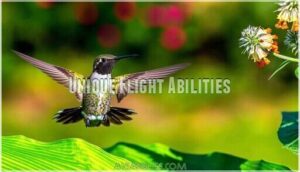This site is supported by our readers. We may earn a commission, at no cost to you, if you purchase through links.

These tiny powerhouses weigh just 2-20 grams yet beat their wings up to 80 times per second, creating figure-eight patterns that let them hover, fly backward, and change direction instantly.
They consume 2-3 times their body weight daily, visiting up to 2,000 flowers while their hearts pump at 1,200 beats per minute.
At night, they enter torpor—a death-like state where their body temperature drops 50 degrees and heart rate plummets to just 50 beats per minute to survive.
Some species migrate 3,900 miles solo, using magnetic fields for navigation after gaining 40% body weight in preparation.
They achieve this remarkable feat by undergoing significant physiological changes, making them one of the most fascinating creatures in the animal kingdom.
Table Of Contents
- Key Takeaways
- The Remarkable World of Hummingbirds
- Hummingbird Anatomy and Physical Characteristics
- Unique Flight Abilities
- Feeding Habits and Diet
- Metabolism and Energy Conservation
- Migration Patterns and Behaviors
- Diversity and Distribution
- Reproduction and Nesting
- Sensory Abilities and Intelligence
- Conservation Efforts and Challenges
- Frequently Asked Questions (FAQs)
- What are 5 facts about hummingbirds?
- How long does a hummingbird live 3 to 5 years?
- What is the basic information about hummingbirds?
- What is the special ability of a hummingbird?
- What are 10 interesting facts about hummingbirds?
- What’s so special about a hummingbird?
- How far can a hummingbird see?
- How many days do hummingbirds live?
- What are 10 hummingbird facts?
- What does hummingbird mean?
- Conclusion
Key Takeaways
- You’ll discover these tiny birds are nature’s most efficient flying machines, weighing just 2-20 grams yet beating their wings up to 80 times per second in figure-eight patterns that allow them to hover, fly backward, and change direction instantly.
- Your understanding of their extreme metabolism will amaze you – they consume 2-3 times their body weight daily while their hearts pump at 1,200 beats per minute, yet they can enter torpor at night where their heart rate drops to just 50 beats per minute to survive.
- You’ll be impressed by their incredible migration abilities, as some species travel 3,900 miles solo using magnetic fields for navigation after gaining 40% of their body weight in preparation for these epic journeys.
- You’ll appreciate their remarkable sensory abilities and intelligence, including superior color perception with UV vision, exceptional spatial memory that rivals GPS systems, and the ability to remember thousands of flower locations with pinpoint accuracy.
The Remarkable World of Hummingbirds
Welcome to the remarkable world of hummingbirds, nature’s most incredible flying machines. These tiny aerial acrobats pack more wonder per ounce than any creature on Earth. Hummingbird facts reveal birds weighing less than a penny yet capable of extraordinary feats that’ll leave you speechless.
With over 360 hummingbird species throughout the Americas, each brings unique charm to garden ecosystems. Their cultural significance spans centuries, with Native American folklore celebrating them as messengers of joy and resilience. Hummingbird symbolism represents life’s precious moments and the power of persistence.
Attracting hummingbirds to your yard means welcoming nature’s jewels home. Their hummingbird behavior includes defending territories fiercely while maintaining hummingbird habitat preferences that shape entire ecosystems.
To deepen your understanding, consider reading identification and conservation guides. These folklore and myths surrounding these creatures capture imaginations worldwide, proving that sometimes the smallest packages contain the biggest surprises.
Hummingbird Anatomy and Physical Characteristics
You’ll be amazed by how these tiny powerhouses pack incredible engineering into bodies smaller than your thumb. Their anatomy defies physics with features that would make any engineer jealous.
Size and Weight
These feathered marvels pack incredible power into impossibly small packages.
Here are five mind-blowing hummingbird facts about their size:
- The Bee Hummingbird measures just 2 inches long—truly the world’s smallest bird
- Average weight ranges from 2-20 grams, lighter than most coins
- Species variation spans dramatically, with giants weighing ten times more than miniatures
- Weight fluctuation occurs seasonally as they bulk up 40% before migration
- Size adaptations and perfect body proportions maximize their nectar-sipping efficiency
The list highlights the remarkable diversity and adaptability of hummingbirds, showcasing their unique characteristics and abilities.
Wing Structure and Flight Capabilities
How do hummingbirds perform aerial acrobatics that defy physics? Their wing structure holds the secret to extraordinary hummingbird flight capabilities.
Hummingbird wing morphology creates unmatched flight performance through specialized adaptations:
- Wing Aerodynamics: Unique shoulder joints rotate 180 degrees, enabling backward flight and precise hovering mechanics
- Rapid Wing Beats: Wings beat up to 80 times per second, creating lift on both upstroke and downstroke
- Flight Speed: Reach 30 mph in straight flight while maintaining instant directional changes
- Hovering Excellence: Figure-eight wing pattern generates continuous lift, allowing stationary flight
- Flexible Structure: Lightweight bones and muscle arrangement optimize power-to-weight ratio for sustained hovering
These remarkable adaptations make hummingbirds nature’s most agile aviators.
Heart and Metabolism
Your hummingbird’s heart pumps like a tiny race car engine, beating up to 1,200 times per minute during flight.
This incredible heart rate fuels their sky-high metabolic rate and energy consumption, making them nature’s ultimate energy burners.
Their heart comprises 2.5% of body weight, a considerable size relative to their overall mass.
- Heart rate drops to 225 beats per minute during rest, still faster than most birds
- Metabolism runs nearly 100 times faster than an elephant’s, requiring constant fuel
- Torpor regulation slows their system at night, conserving precious energy for survival
Unique Flight Abilities
You’ve probably seen hummingbirds zip around your garden, but you mightn’t realize they’re the only birds that can fly backward and hover like tiny helicopters.
These aerial acrobats can also fly upside-down and reach speeds of 37 mph, making them nature’s most versatile flying machines.
Hovering and Backward Flight
These aerial acrobats defy gravity through extraordinary muscle control and aerodynamic principles.
Their unique shoulder joints enable wing rotation up to 180 degrees, creating flight stability others can’t match.
Their acrobatic flight includes:
- Figure-eight wing patterns for precise hovering
- Backward flight through reversed wing strokes
- Instantaneous direction changes via wing angle adjustments
- Sustained hovering despite massive energy expenditure.
This evolutionary advantage comes with costs—hovering burns tremendous calories, requiring constant refueling to maintain their high-energy lifestyle.
Speed and Maneuverability
Speed records fall when hummingbirds activate their flight muscles.
These powerhouses generate wingbeat frequency up to 80 beats per second, enabling lightning-fast aerodynamic adaptations.
You’ll witness incredible agility as they execute sharp turns and sudden stops mid-flight.
Their specialized wing rotation creates lift during both upstrokes and downstrokes, making acrobatic flight possible.
Beyond hovering techniques and backward flight, they dart forward at 37 mph—faster than you’d expect from such tiny aviators.
Feeding Habits and Diet
You’d be amazed by how much these tiny birds eat to fuel their incredible energy needs.
Hummingbirds consume 2-3 times their body weight daily, visiting up to 2,000 flowers while also hunting insects for essential protein.
Nectar Consumption
Sweet liquid fuel powers every hummingbird’s incredible aerial show.
These tiny acrobats consume nearly half their body weight in nectar daily, visiting up to 2,000 flowers.
Their forked tongues lap nectar 15-20 times per second, extracting over 90% of available sugars within just 20 minutes of digestion.
Many enthusiasts purchase pre-made nectar solutions for convenience.
Nectar Preference highlights:
- Visit flowers every 10-15 minutes throughout daylight hours
- Digest sugar water with 90% efficiency in under 20 minutes
- Increase daily energy intake to 8x body weight during migration
- Scout 1,000-2,000 different flowers daily for ideal feeding habits
Insect Predation
While hummingbirds sip nectar, they’re also skilled hunters who devour thousands of tiny insects daily.
Their hunting techniques are impressive:
- Mid-flight captures using precision and speed
- Gleaning insects from spider webs and bark
- Prey selection focuses on gnats, mosquitoes, and aphids
- Insect importance provides amino acids nectar can’t supply
These aerial acrobats need protein for muscle development and egg production, making insect nutrition vital for survival.
Pesticide effects threaten their food sources, while spiders occasionally turn the tables on these tiny hummingbird predators.
This hummingbird diet balance between nectar and bugs guarantees they get complete nutrition for their high-energy lifestyle.
Specialized Tongue Structure
Beyond catching insects, you’ll discover their tongues are engineering marvels.
Tongue Morphology reveals a forked, W-shaped structure with grooved edges that creates capillary action for nectar uptake.
When feeding on tubular flowers, tongue protraction extends twice the bill’s length, lapping 15-20 times per second.
The groove action works like tiny straws, drawing nectar through surface tension rather than suction.
This hummingbird facts gem shows perfect coevolution – their tongue structure matches flower shapes precisely.
The bifurcated tips trap liquid while serrated edges help capture small insects, making these specialized tongues incredibly efficient multi-tools for survival.
These adaptations highlight tongue diversity across species, demonstrating a remarkable example of tongue diversity and specialized tongues.
Metabolism and Energy Conservation
You’ve probably never thought about how a tiny hummingbird manages to power its incredibly fast lifestyle, but these birds have developed one of nature’s most extreme energy management systems.
Nature’s tiniest powerhouses run on metabolic engines that burn brighter than rocket fuel
Their metabolism runs nearly 100 times faster than an elephant’s, yet they’ve mastered the art of conservation through a remarkable ability called torpor that lets them dramatically slow down their body functions when food becomes scarce.
Torpor State
Nature’s ultimate survival mechanism kicks in when you least expect it.
Hummingbirds enter torpor, a sleep-like state that dramatically slows their metabolism during cold nights or food shortages.
This incredible energy conservation strategy involves three key adaptations:
- Body temperature drops from 104°F to as low as 48°F
- Heart rate plummets from 1,200 beats per minute to just 50
- Metabolic slowdown reduces energy needs by up to 95%
Torpor duration varies by species and conditions, lasting 2-20 hours.
The arousal process takes 20-60 minutes as these tiny powerhouses gradually warm up and return to normal activity.
Rapid Heartbeat and Breathing
When you’re not in torpor, your heart rate skyrockets to meet incredible metabolic demands.
Your cardiovascular system pumps at 1,200 beats per minute during flight—that’s twenty times faster than yours.
Your respiratory rate matches this frantic pace, with oxygen intake supporting massive energy expenditure.
This bird anatomy marvel keeps your tiny engine running at peak performance levels.
Heavy breathing can indicate avian respiratory distress, which may suggest avian respiratory issues or massive energy expenditure.
Migration Patterns and Behaviors
You’ll be amazed to discover that these tiny aerial athletes are some of nature’s most impressive long-distance travelers, with some species journeying thousands of miles twice a year.
Unlike most migrating birds that travel in flocks for safety, hummingbirds are solo adventurers who navigate their epic journeys completely alone, making them remarkable for their ability to undertake such feats.
Long-Distance Journeys
These tiny travelers set out on incredible journeys that’ll leave you speechless. Migration triggers like shorter daylight hours signal it’s time to move, launching longdistance migration adventures spanning thousands of miles.
The Gulf crossing represents their most dangerous challenge—a 500-mile nonstop flight requiring precise timing and energy reserves.
Migration patterns reveal amazing strategies:
- Alaskan migration routes cover 3,900 miles for Rufous hummingbirds
- Fueling migration requires gaining 40% body weight in fat stores
- Migratory speed averages 20-30 mph during direct flights
- Bird migration occurs individually, not in flocks like other species.
These epic hummingbird migration journeys showcase nature’s most impressive navigation skills.
Solo Travel
Hummingbird migration represents one of nature’s most impressive solo acts.
Unlike geese or cranes, hummingbirds don’t travel in flocks—each bird navigates its own route using remarkable memory and instinct.
These tiny travelers must master route learning, danger avoidance, and finding food sources during their journey.
Rest stops become critical for survival during these epic adventures.
They also rely on detecting magnetic fields to aid in orientation.
| Challenge | Solution |
|---|---|
| Route Learning | Mental mapping of landmarks and magnetic fields |
| Finding Food | Memory of reliable nectar sources along migration paths |
| Danger Avoidance | Solo travel reduces predator detection risks |
Diversity and Distribution
You’d be amazed to learn that over 360 unique hummingbird species exist exclusively in the Americas, with the greatest diversity found in the tropical Andes mountains and Central America.
While North America hosts only about 15 regularly seen species, South America boasts hundreds of varieties, from the tiny bee hummingbird weighing just 1.5 grams to larger species reaching 13 centimeters in length, including the fact that they range from the smallest to the larger species reaching.
Species Count and Variety
Prepare to immerse yourself in nature’s most diverse flying family! With over 366 recognized hummingbird species across the Americas, these aerial acrobats showcase incredible variety.
Colombia leads global distribution with 165 species, while Andean diversity creates perfect conditions for species identification challenges. Recent genetic research reveals ongoing hybridization events, complicating bird species classification but enriching our understanding of evolution. Their prevalence is exclusive to the Western Hemisphere.
Here’s what makes hummingbird species so remarkable:
- Eight species face critical conservation status requiring immediate protection
- 112 distinct genera demonstrate extraordinary bird species diversity
- Types of hummingbirds range from tiny bee hummingbirds to giant varieties
- Hummingbird identification becomes easier with specialized field guides
This incredible variety means you’ll never run out of new species to discover in your backyard adventures!
Geographic Range
These incredible birds call only the Western Hemisphere home, with species distribution spanning from Alaska’s chilly wilderness down to South America’s tip.
You’ll find amazing habitat variation across their range—from sea-level deserts to mountains reaching 14,700 feet in altitudinal range.
North America hosts just 15 species, while South America boasts 290+ varieties.
Their migration routes stretch thousands of miles, with some traveling between Alaska and Mexico annually, showcasing remarkable range expansion capabilities throughout Central America.
They primarily rely on nectar, but also consume insects for protein.
Reproduction and Nesting
You’ll be amazed by hummingbirds’ incredible nesting skills and reproductive strategies.
These tiny architects create some of nature’s most remarkable nurseries while managing one of the animal kingdom’s most demanding parenting challenges.
Nest Construction
Master architects work their magic with spider silk and plant fibers, creating stretchy, expandable hummingbird nests.
These nest materials form cup-shaped homes roughly walnut-sized. Smart nest location choices include thin branches in dense foliage.
Perfect nest camouflage uses lichen and moss exteriors, making them nearly invisible to predators. For specialized crafting, consider exploring diverse hummingbird nesting products.
Unlike many birds, nest reuse rarely occurs—females typically build fresh structures each nesting season for ideal maternal care.
Egg Laying and Incubation
After building their cozy nest, female hummingbirds get down to business with egg-laying that’s nothing short of miraculous.
You’ll be amazed by these tiny reproduction facts:
- Clutch size: Typically 2 pearl-white eggs, rarely 1 or 3
- Incubation period: 14-23 days of dedicated warming
- Nestling care: Mom handles everything solo – no dad in sight
- Hatching process: Babies emerge naked, blind, and helpless
These hummingbird eggs measure just 0.5 inches – smaller than jellybeans!
The female’s parental roles include constant temperature regulation through body heat. She’ll rarely leave her hummingbird nests during incubation, creating perfect conditions for successful hatching.
This nesting period showcases remarkable hummingbird facts about maternal dedication.
Sensory Abilities and Intelligence
You’d be amazed at how hummingbirds see the world around them with vision that puts human eyesight to shame.
These tiny birds possess remarkable spatial memory that rivals GPS navigation systems, allowing them to remember thousands of flower locations with pinpoint accuracy, which is a testament to their pinpoint abilities.
Vision and Color Perception
Most hummingbird facts reveal incredible visual acuity that puts our eyesight to shame.
You’re seeing only a fraction of what they perceive—these tiny birds detect ultraviolet perception and have superior color discrimination abilities.
Their UV vision helps identify floral cues invisible to us, while exceptional motion detection tracks fast-moving insects.
This bird vision reveals hidden colors and iridescence patterns, making their world far more vibrant than ours.
Spatial Memory
Beyond their remarkable visual abilities, you’d be amazed by hummingbirds’ exceptional spatial memory. Their tiny hippocampus stores detailed cognitive maps that rival GPS systems.
Through careful hummingbird observation, scientists discovered these hummingbird facts: they remember thousands of precise locations with incredible accuracy. It’s fascinating to reflect on the fact that, like other birds, they exhibit impressive avian brain structure.
Their spatial memory enables sophisticated foraging strategies including:
- Route optimization between flower patches to maximize energy efficiency
- Exact feeder locations and refill schedules in backyard environments
- Safe nest site coordinates for breeding and roosting purposes
- Nectar replenishment timing at individual blooms throughout their territory
This bird memory system guarantees they’ll never waste precious energy searching randomly—they know exactly where their next meal awaits.
Conservation Efforts and Challenges
You’ve probably admired these tiny birds without realizing they’re fighting for survival against habitat loss and climate change.
Conservation groups are working hard to protect critical breeding grounds and migration routes, but many hummingbird species still face uncertain futures due to climate change.
Endangered Species
You’re looking at a heartbreaking reality – 21 hummingbird species face extinction today.
Eight species are Critically Endangered, with some populations dropping below 50 birds.
Habitat loss from deforestation destroys 80% of their homes, while climate change disrupts flowering times.
Pesticide use poisons their food sources.
The rufous hummingbird lost 67% of its population since 1970, showing how quickly these jeweled fliers can vanish without urgent hummingbird conservation efforts.
Habitat Protection Initiatives
Organizations worldwide champion bird habitats preservation through strategic bird conservation initiatives.
Land Conservation programs protect millions of acres while community partnerships restore degraded ecosystems.
Native Plants initiatives help landowners create hummingbird-friendly spaces, and Reducing Pesticides protects both birds and their insect prey.
You can help protect birds by purchasing related products.
Habitat restoration projects focus on planting native nectar sources while removing invasive species that threaten local ecosystems.
These bird habitats restoration efforts address Climate Change impacts through adaptive management.
Feeder Placement education and bird species conservation monitoring guarantee long-term success across migration corridors.
Frequently Asked Questions (FAQs)
What are 5 facts about hummingbirds?
You’ll discover these tiny aerial acrobats weigh just three grams yet beat their wings 50+ times per second.
They’re America’s only backward-flying birds, consuming nectar from 2,000 flowers daily while migrating thousands of miles solo.
How long does a hummingbird live 3 to 5 years?
Most hummingbirds live 3-5 years in the wild, though some reach 8-10 years. You’ll find their lifespan depends on species, predators, weather, and food availability throughout their range.
What is the basic information about hummingbirds?
Imagine creatures so tiny they weigh less than a penny, yet they’re nature’s most incredible athletes.
You’ll find these remarkable birds beating their wings up to 99 times per second, hovering effortlessly while sipping nectar from flowers with their specialized tongues.
What is the special ability of a hummingbird?
You’ll marvel at their unique hovering ability – they’re the only birds that can fly backwards, sideways, and stay perfectly still mid-air while feeding from flowers.
What are 10 interesting facts about hummingbirds?
You’ll find these tiny birds weigh less than a penny, beat their wings 50+ times per second, and can fly backward.
They visit 2,000 flowers daily, migrate thousands of miles alone, and have hearts beating 1,200 times per minute during flight, which is a remarkable feat considering they accomplish this while also being able to fly backward.
What’s so special about a hummingbird?
You’re witnessing nature’s ultimate aerial acrobat – the only birds that fly backwards, hover motionless, and beat wings up to 90 times per second while weighing less than a penny.
How far can a hummingbird see?
You’ll be amazed to learn that hummingbirds possess exceptional visual acuity, allowing them to spot tiny insects and flowers from considerable distances while maintaining their lightning-fast, precision flight patterns.
How many days do hummingbirds live?
Life’s a brief candle for you when you’re watching hummingbirds.
These energetic birds typically live 3-5 years in the wild, though many don’t survive their challenging first year.
That translates to roughly 1,095-1,825 days of their remarkable existence.
The average hummingbird lifespan is influenced by various hummingbird life factors, which can affect their overall lifespan.
What are 10 hummingbird facts?
You’ll discover these tiny powerhouses weigh just three grams.
They beat their wings over 50 times per second, fly backwards, consume half their body weight daily, and migrate thousands of miles alone.
What does hummingbird mean?
Ever wondered what that tiny aerial acrobat in your garden represents?
The term "Hummingbird" comes from the distinctive humming sound their rapidly beating wings create—up to 80 beats per second—as they hover and dart between flowers, which is a complete concept that defines these birds.
Conclusion
Ironically, these seemingly delicate creatures rank among nature’s toughest survivors, defying physics with every wingbeat.
You’ve now explored incredible hummingbird facts information that reveals how these tiny athletes accomplish impossible feats.
From surviving brutal migrations to entering death-like torpor states, hummingbirds prove that size doesn’t determine strength.
These remarkable birds continue challenging our understanding of flight, metabolism, and endurance in the natural world, showcasing their remarkable ability to accomplish impossible feats.
















